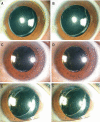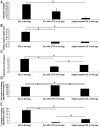Efficacy of haptic sutured in-the-bag intraocular lens for intraocular lens-capsule complex stability: a comparison of three insertion methods
- PMID: 36124202
- PMCID: PMC9453399
- DOI: 10.18240/ijo.2022.09.09
Efficacy of haptic sutured in-the-bag intraocular lens for intraocular lens-capsule complex stability: a comparison of three insertion methods
Abstract
Aim: To evaluate the efficacy and stability of haptic sutured in-the-bag intraocular lens (IOL) in eyes with zonular instability.
Methods: A total 60 eyes of 60 patients were included in this retrospective cohort study. Postoperative stability in three groups [haptic sutured IOL in the bag, IOL in the bag insertion with haptics oriented toward areas of zonulysis, IOL with capsular tension ring (CTR) in the bag insertion] were compared according to the IOL insertion methods. To evaluate the IOL stability, the changes of anterior chamber depth (ACD), refraction, contraction of anterior continuous curvilinear capsulotomy (CCC) area, and tilt of IOL were compared.
Results: There was no significant difference in change of ACD (-0.04±0.01 mm in group of haptic sutured IOL, -0.07±0.01 mm in group of CTR insertion) and refraction (0.05±0.05 D in group of haptic sutured IOL, 0.37±015 D in group of CTR insertion) between the group of haptic sutured IOL in the bag and CTR insertion group. But in comparison of CCC contraction and IOL tilt, CTR insertion group showed less contraction (1.00%±0.52%) and less IOL tilt (2.66°±0.11°) than the group of haptic sutured IOL in the bag (6.32%±1.36%, 3.47°±0.11°, respectively). The CTR insertion group showed the least CCC contraction and the least tilt.
Conclusion: In eyes with zonular instability, the method of haptic sutured IOL in-the-bag shows comparable stability in ACD and refraction in comparison with IOL with CTR in the bag insertion. The method of IOL only in-the-bag insertion shows the largest contraction of CCC and the largest tilt of IOL.
Keywords: capsular tension ring; haptic sutured in the bag; zonular instability.
International Journal of Ophthalmology Press.
Figures






Similar articles
-
Influence of a Capsular Tension Ring on Capsular Bag Behavior of a Plate Haptic Intraocular Lens: An Intraindividual Randomized Trial.Ophthalmology. 2024 Apr;131(4):445-457. doi: 10.1016/j.ophtha.2023.10.031. Epub 2023 Oct 31. Ophthalmology. 2024. PMID: 37914042 Clinical Trial.
-
[Clinical efficacy of management of zonular abnormalities with capsular tension ring: a two-year follow-up study].Zhonghua Yan Ke Za Zhi. 2007 Jun;43(6):519-24. Zhonghua Yan Ke Za Zhi. 2007. PMID: 17897529 Chinese.
-
Effect of a capsular tension ring on the shape of the capsular bag and opening and the intraocular lens.J Cataract Refract Surg. 2001 Mar;27(3):452-6. doi: 10.1016/s0886-3350(00)00610-6. J Cataract Refract Surg. 2001. PMID: 11255060
-
Posterior capsulorhexis combined with optic buttonholing: an alternative to standard in-the-bag implantation of sharp-edged intraocular lenses? A critical analysis of 1000 consecutive cases.Graefes Arch Clin Exp Ophthalmol. 2008 Jun;246(6):787-801. doi: 10.1007/s00417-008-0779-6. Epub 2008 Apr 19. Graefes Arch Clin Exp Ophthalmol. 2008. PMID: 18425525 Free PMC article. Review.
-
Intraocular lens optic capture.J Cataract Refract Surg. 2004 Jan;30(1):200-6. doi: 10.1016/j.jcrs.2003.11.035. J Cataract Refract Surg. 2004. PMID: 14967291 Review.
References
-
- Weber CH, Cionni RJ. All about capsular tension rings. Curr Opin Ophthalmol. 2015;26(1):10–15. - PubMed
-
- Hayashi K, Hirata A, Hayashi H. Possible predisposing factors for In-the-bag and out-of-the-bag intraocular lens dislocation and outcomes of intraocular lens exchange surgery. Ophthalmology. 2007;114(5):969–975. - PubMed
LinkOut - more resources
Full Text Sources
